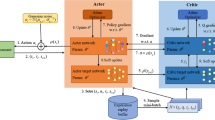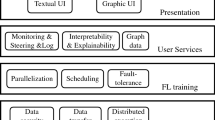Abstract
Federated learning is widely used in the context of wireless networks to protect sensitive user data. However, centralized federated learning encounters some issues when applied to the Social Internet of Vehicles, specifically low communication efficiency and high computational cost. In order to alleviate communication bottlenecks and protect vehicle user data privacy, we herein propose the Conditional Choice Probability-Federated Deep Learning algorithm based on user trust chain. This algorithm introduces inter-user trust elements to characterize the vehicle connection network from a vehicle-user relationship perspective. It computes the node conditional choice trust probability based on the single-way trust atomic chain and circular chain of user nodes. Local model interactions are then performed to complete the decentralized federated deep learning framework. Experiments are conducted to verify the robustness of the proposed algorithm's conditional choice probability estimation and confirm that decentralized federated deep learning is effective.






Similar content being viewed by others
References
Vegni, A. M., & Loscri, V. (2015). A survey on vehicular social networks. IEEE Communications Surveys & Tutorials, 17(4), 2397–2419. https://doi.org/10.1109/COMST.2015.2453481
Gao, Honghao, Liu, Can, Li, Youhuizi, & Yang, Xiaoxian. (2020). V2VR: Reliable hybrid-network-oriented V2V data transmission and routing considering RSUs and connectivity probability. IEEE Transactions on Intelligent Transportation Systems, 22(6), 3533–3546. https://doi.org/10.1109/TITS.2020.2983835
Zhou, W., Xing, L., Xia, J., Fan, L., & Nallanathan, A. (2021). Dynamic computation offloading for MIMO mobile edge computing systems with energy harvesting. IEEE Transactions on Vehicular Technology, 70(5), 5172–5177. https://doi.org/10.1109/TVT.2021.3075018
Vegni, A. M., Souza, C., Loscri, V., Hernandez-Orallo, E., & Manzoni, P. (2019). Data transmissions using hub nodes in vehicular social networks. IEEE Transactions on Mobile Computing., 19(7), 1570–1585. https://doi.org/10.1109/TMC.2019.2928803
Jia, X., Xing, L., Gao, J., & Honghai, W. (2020). A survey of location privacy preservation in social internet of vehicles. IEEE Access, 8, 201966–201984. https://doi.org/10.1109/ACCESS.2020.3036044
Xue, B., He, Y., Jing, F., Ren, Y., Jiao, L., & Huang, Y. (2021). Robot target recognition using deep federated learning. International Journal of Intelligent Systems. https://doi.org/10.1002/int.22606
Gao, H., Zhang, Y., Miao, Hu., Durán, R. J., & Barroso, X. Y. (2021). SDTIOA: Modeling the timed privacy requirements of iot service composition: a user interaction perspective for automatic transformation from BPEL to timed automata. Mobile Networks and Applications. https://doi.org/10.1007/s11036-021-01846-x
Zhang, H., Xie, Z., Zarei, R., Wu, T., & Chen, K. (2021). Adaptive client selection in resource constrained federated learning systems: A deep reinforcement learning approach. IEEE Access, 9, 98423–98432. https://doi.org/10.1109/ACCESS.2021.3095915
Zhang, Y., Mou, Z., Gao, F., Xing, L., Jiang, J., & Han, Z. (2020). Hierarchical deep reinforcement learning for backscattering data collection with multiple UAVs. IEEE Internet of Things Journal, 8(5), 3786–3800.
Hao M, Li H, Xu G, Liu S, & Yang H. (2019). Towards efficient and privacy-preserving federated deep learning. IEEE International Conference on Communications (IEEE ICC). c31201213c653abb.
Zhang L, Yin H, Zhou Z, Roy S, & Sun Y. (2020). Enhancing WiFi multiple access performance with federated deep reinforcement learning. 92nd IEEE Vehicular Technology Conference (IEEE VTC-Fall). https://doi.org/10.1109/VTC2020-Fall49728.9348485.
Nasaruddin, N., Muchtar, K., & Afdhal, A. (2019). A lightweight moving vehicle classification system through attention-based method and deep learning. IEEE Access, 7, 157564–157573. https://doi.org/10.1109/ACCESS.2019.2950162
Kim, H., Park, J., Bennis, M., & Kim, S. L. (2020). Blockchained on-device federated learning. IEEE Communications Letters, 24(6), 1279–1283. https://doi.org/10.1109/LCOMM.2019.2921755
Qi, Y., Hossain, M. S., Nie, J., & Li, X. (2021). Privacy-preserving blockchain-based federated learning for traffic flow prediction. Future Generation Computer Systems, 117(2946), 328–337. https://doi.org/10.1016/j.future.2020.12.003
Wei, K., Li, J., Ding, M., Ma, C., Yang, H. H., Farokhi, F., Jin, S., Quek, T. Q., & Poor, H. V. (2020). Federated learning with differential privacy: Algorithms and performance analysis. IEEE Transactions on Information Forensics and Security, 15, 3454–3469. https://doi.org/10.1109/TIFS.2020.2988575
Li, Y., Zhang, Z., Zhang, Z., & Kao, Y. C. (2020). Secure federated learning with efficient communication in vehicle network. Journal of Internet Technology, 21(7), 2075–2084. https://doi.org/10.3966/160792642020122107022
Brendan McMahan, H., Moore, E., Ramage, D., Hampson, S., & Agüera y Arcas, B. (2017). Communication-efficient learning of deep networks from decentralized data.54: 1273–1282.
Wenchen, H., Guo, S., Qiu, X., Liandong, C., & Zhang, S. (2021). Federated learning node selection method based on DRL. Journal of Communications., 42(06), 62–71.
Yu, S., Chen, X., Zhou, Z., Gong, X., & Wu, D. (2020). When deep reinforcement learning meets federated learning: intelligent multi-timescale resource management for multi-access edge computing in 5g ultra dense network. IEEE Internet of Things Journal. https://doi.org/10.1109/JIOT.2020.3026589
Liu, H., Zhang, P., Pu, G., Yang, T., & Zhang, Y. (2020). Blockchain empowered cooperative authentication with data traceability in vehicular edge computing. IEEE Transactions on Vehicular Technology., 69(4), 4221–4232.
Yu, Z., Hu, J., Min, G., Zhao, Z., Miao, W., & Hossain, M. (2021). Mobility-aware proactive edge caching for connected vehicles using federated learning. IEEE Transactions on Intelligent Transportation Systems, 22(8), 5341–5351.
Olowononi, F. O., Rawat, D. B., & Liu, C, (2021). Federated learning with differential privacy for resilient vehicular cyber physical systems. 2021 IEEE 18th Annual Consumer Communications & Networking Conference (CCNC), pp. 1–5, https://doi.org/10.1109/CCNC49032.2021.9369480.
Ye, D., Yu, R., Pan, M., & Han, Z. (2020). Federated learning in vehicular edge computing: A selective model aggregation approach. IEEE Access, 8, 23920–23935. https://doi.org/10.1109/ACCESS.2020.2968399
Boualouache, A., & Engel, T. (2021). Federated learning-based scheme for detecting passive mobile attackers in 5G vehicular edge computing. Annals of Telecommunications. https://doi.org/10.1007/S12243-021-00871-X
Li, Z. H., Yu, H. F., Zhou, T. Y., Luo, L., & Fan, M. C. (2021). Byzantine resistant secure blockchained federated learning at the edge. IEEE Network., 35(4), 295–301.
Cao, M., Zhang, L., & Cao, B. (2021). Toward on-device federated learning: A direct acyclic graph-based Blockchain approach. IEEE Transactions on Neural Networks and Learning Systems. https://doi.org/10.1109/TNNLS.2021.3105810
Raj J. T. (2020). Building decentralized image classifiers with federated learning. IEEE-Region-10 Symposium (TENSYMP) - Technology for Impactful Sustainable Development.489–494.https://doi.org/10.1109/TENSYMP50017.2020.9230771.
Pokhrel, S. R., & Choi, J. (2020). Federated learning with blockchain for autonomous vehicles: Analysis and design. IEEE Transactions on Communications., 68(8), 4734–4746. https://doi.org/10.1109/TCOMM.2020.2990686
Yuan, P., & Huang, R. (2021). Integrating the device-to-device communication technology into edge computing: A case study[J]. Peer-to-Peer Networking and Applications, 14(2), 599–608. https://doi.org/10.1007/s11036-021-01846-x
Wu, H., Fan, Y., Wang, Y., Ma, H., & Xing, L. (2021). A comprehensive review on edge caching from the perspective of total process: Placement, policy and delivery. Sensors, 21, 5033. https://doi.org/10.3390/s21155033
Xing, L., Jia, X., Gao, J., & Wu, H. (2021). A location privacy protection algorithm based on double K-anonymity in the social internet of vehicles. IEEE Communications Letters., 25(10), 3199–3203.
Ma, X., Xu, H., Gao, H., & Bian, M. (2021). Real-time multiple-workflow scheduling in cloud environment. Journal of Cloud Computing. https://doi.org/10.21203/rs.3.rs-170491/v1
Yuan, P., Fan, L., Liu, P., & Tang, S. (2016). Recent progress in routing protocols of mobile opportunistic networks: A clear taxonomy, analysis and evaluation. Journal of Network and Computer Applications, 62, 163–170.
Tan, C., Bei, S., Jing, Z., & Xiong, N. (2021). An atomic cross-chain swap-based management system in vehicular Ad hoc networks. Wireless Communications and Mobile Computing, 2021(7), 25. https://doi.org/10.1155/2021/6679654
Zakhary, V., Agrawal, D., & Abbadi, A. E. (2019). Atomic commitment across Blockchains. Proceedings of the Vldb Endowment, 13(9), 1319–1331.
Seo, H., Park, J., Bennis, M., & Choi, W. (2021). Communication and consensus co-design for distributed, low-latency, and reliable wireless systems. IEEE Internet of Things Journal., 8(1), 129–143. https://doi.org/10.1109/JIOT.2020.2997596
Zhang, Y., Lu, Y., Huang, X., Zhang, K., & Maharjan, S. (2020). Blockchain empowered asynchronous federated learning for secure data sharing in internet of vehicles. IEEE Transactions on Vehicular Technology., 69(4), 4298–4311. https://doi.org/10.1109/TVT.2020.2973651
Li, S., Xue, M., Zhao, B., Zhu, H., & Zhang, X. (2020). Invisible backdoor attacks on deep neural networks via steganography and regularization. IEEE Transactions on Dependable and Secure Computing., 18(5), 2088–2015.
Zhang, Y. Y., Shang, J., Chen, X., & Liang, K. (2020). A self-learning detection method of Sybil attack based on LSTM for electric vehicles. Energies, 13(6), 1–15.
Agrawal, S., Das, M. L., & Lopez, J. (2019). Detection of node capture attack in wireless Sensor networks. IEEE Systems Journal., 13(1), 238–247. https://doi.org/10.1109/JSYST.2018.2863229
Wu, S., Chen, J., Zhou, W., Iqbal, J., & Yao, L. (2019). A modified Logit model for assessment and validation of debris-flow susceptibility. Bulletin of Engineering Geology and the Environment, 78(6), 4421–4438.
Zhu, Q., Zheng, Y., & Li, G. (2018). Linear double autoregression. Journal of Econometrics., 207(1), 162–174. https://doi.org/10.1016/j.jeconom.2018.05.006
Author information
Authors and Affiliations
Corresponding author
Additional information
Publisher's Note
Springer Nature remains neutral with regard to jurisdictional claims in published maps and institutional affiliations.
Rights and permissions
About this article
Cite this article
Zhao, PC., Huang, YH., Zhang, DX. et al. CCP-federated deep learning based on user trust chain in social IoV. Wireless Netw 29, 1555–1566 (2023). https://doi.org/10.1007/s11276-021-02870-1
Accepted:
Published:
Issue Date:
DOI: https://doi.org/10.1007/s11276-021-02870-1




